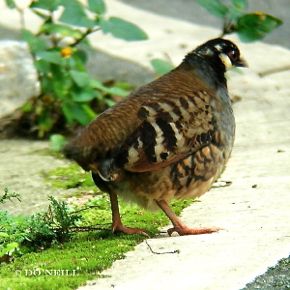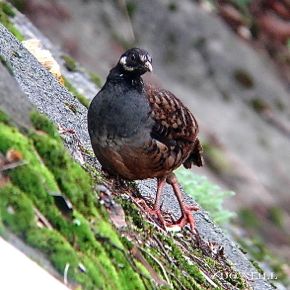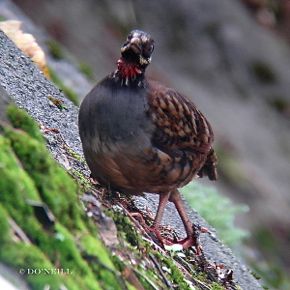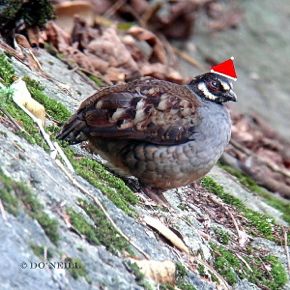“Three species of Malayan named endemics – Malayan Partridge (Arborophila campbelli), Malayan Whistling-Thrush (Myophonus robinsoni) and Malayan Peacock-pheasant (Polyplectron malacense) are probably the Magnificent 3, birders and bird photographers would love an encounter; at least once in a life time in pursuit of their hobbies and passion for birds in Peninsular Malaysia.
“Fervent pursuit of the Magnificent 3 can be but disappointing for they are not easy birds to go looking for. But given time, patience, a huge dose of luck, one may be rewarded when they would show up unexpectedly and put on an unforgettable show just for you alone. What an excitement that would be in that milestone of birding passionate. Or… would one rather chase and entice the Magnificent 3 out, see all within a year and get jaded for life?
“My first endemic encounter with a covey of Malayan Partridges finally came in my second decade of full- time bird watching and photography on 10th October, 2011 in Fraser’s Hill, Pahang, Peninsular Malaysia (1310m a.s.l.)
“A dumpy, grey looking bird was spotted looking a bit lost standing at road edge of hill resort, as I drove passed. I took my vehicle to a quick halt and made hasty preparation to observe and photograph this monotypic species while I hid behind a bush.
“The Malayan Partridge is quite a recent split from the Grey-Breasted Partridge (Arborophila orientalis) following Mees. G.F. (1996) geographical variation in Birds of Java. Further reference to taxonomic notes may be had at Oriental Bird Images HERE.
“An endemic of sub-montane broad-leaved and evergreen forest, they thrive and forage in small covey, 1000-1600m a.s.l. in Peninsular Malaysia.
“The ground dwelling bird was walking on road edge and appeared to be searching. Finally, found a spot and was observed to bear down, ballooned its abdomen and ejected a huge, smooth and grey, profiterole looking ‘poop’ (above).
“While the bird walked away innocently with that ‘You didn’t see that’ look, two years on I sat and wondered why I did not pursue further to inspect and probed bird poop. It was a chance opportunity to view/study diet of the partridge. While I was trained in the past to inspect and detect abnormalities in Homo sapiens, I had overlooked from bird science point of view in normalcy. Mmm… I certainly had wasted no time ‘throwing out dirty water with baby in it’!
“Sounds of scuffle and thrashing in the undergrowth above were heard. Description calls of A. campbelli may be heard HERE.
“Following the scuffle, a dumpy bird suddenly appeared and seen rolling down the slope of the concrete embankment. The vanquished, sub-adult looking bird with more rufous body, greyer chest and belly had lost its grace. Having regained its composure, the bird with two strong, pinky clawed feet was observed clinging and scaling the 45 degrees slope, concrete embankment with ease (below left).
“Several disgruntled calls were made showing red, bare skin over throat as the Partridge bellowed. The vanquished bird turned and stared at me – an embarrassing, expression look caught in the act.
‘You’re not supposed to see that (above right)!
“Was it a sibling squabble or the near adult was testing his adulthood too soon only to receive the right message from the patriarch?
“I suspect the partridge that pooped could be the female. Assuming that to be so, she was oblivious to what was going on, couldn’t care less whilst going about foraging at the foot of the slope. Breeding period is known to be short from March-April.
“Here is a comparison image of an adult (below) and the vanquished sub-adult (above) – in the image at left.
“The assuming female was feeling relaxed and even had time for a few ‘shut eyes.’ The classical plumage description of an adult Malayan Partridge is photographed here, the way best described in Craig Robson’s “A Field Guide to the Birds of South-East Asia’ (left).
“A total 14 minutes of golden opportunity observation was had before the covey retreated into the forest – making this 38th article, the closing number for articles posted into BESG for 2013.
“We wish all readers Peaceful Christmas and all good wishes for the New Year 2014 – from all the birds, the privilege they gave to showcase themselves through Avian Writer.
Avian Writer Daisy O’Neill
Penang, Malaysia
3rd December 2013
Copyright article and all copy images – Courtesy of Daisy O’Neill Bird Conservation Fund














